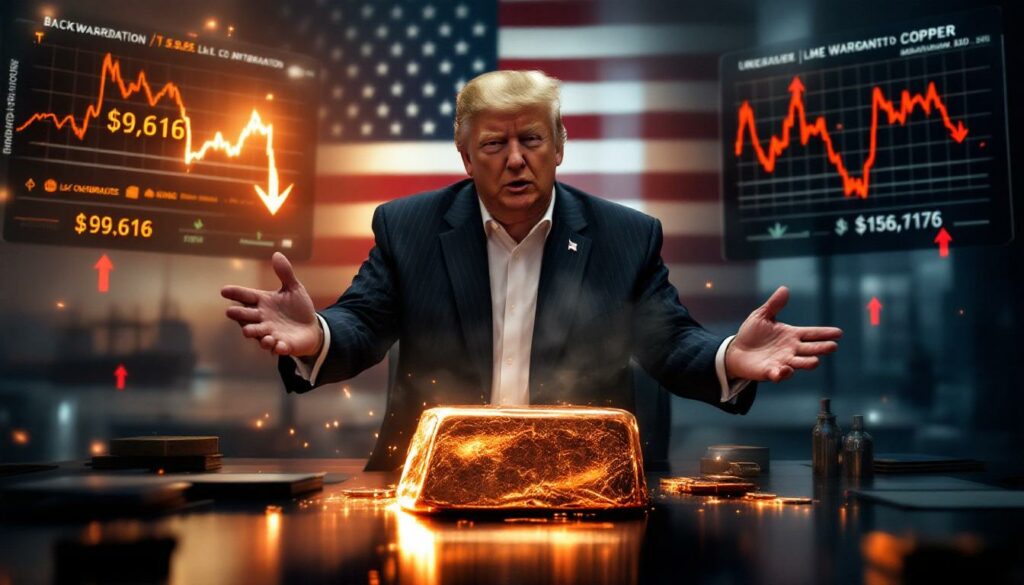Understanding LME Copper Tariffs and Pricing Uncertainty: Market Impact Analysis
Recent developments in the copper market have created significant uncertainty as potential tariffs loom on the horizon. LME copper has experienced notable price volatility, with market participants struggling to navigate a rapidly changing landscape shaped by policy announcements and supply chain concerns.
The copper market finds itself at a pivotal moment as traders grapple with both immediate price impacts and longer-term structural uncertainties. The introduction of substantial tariffs would reshape global copper flows, creating both challenges and opportunities across the value chain.
Recent Price Movements and Market Reaction
LME copper prices dropped 1.81% to $9,616 per tonne on July 7, 2025, representing the largest decline among base metals during morning trading. This significant decrease occurred after market momentum stalled at the psychological $10,000 per tonne threshold, a key resistance level closely watched by technical traders.
Perhaps more concerning for market participants was the structural shift that accompanied the price decline. The previous triple-digit backwardation—where spot prices exceed futures prices, indicating immediate scarcity—flipped to a small contango of $2 per tonne. This reversal signals a fundamental change in market psychology, with traders now more concerned about near-term oversupply than immediate scarcity.
"Spats of fresh copper inflow have capped the upward price momentum at $10,000 per tonne," noted analyst Andy Farida, explaining the structural shift. "This has flipped the previous triple-digit backwardation into a small contango of $2 per tonne."
Adding to bearish sentiment, LME copper inventories increased by 4,625 tonnes to reach 107,125 tonnes—a 4.5% increase in a single day that further pressured prices. This inventory build suggests traders may be positioning metal in anticipation of changing market dynamics.
Proposed Tariff Structure and Timeline
At the center of market uncertainty is the potential implementation of a 50% tariff on copper imports to the United States. Commerce Secretary Howard Lutnick indicated implementation would occur by July 31 or August 1, 2025, creating an extremely tight timeline for market participants to adjust positions and supply chains.
The tariff announcement comes as part of a broader Section 232 investigation into copper imports, which authorizes trade measures based on national security concerns. However, copper's essential role in both civilian infrastructure and defense applications complicates this justification, creating further uncertainty about potential exemptions or modifications.
As of the latest updates, no specific exemptions have been announced for trading partners, unlike previous metal tariffs that initially included carve-outs for allies. This comprehensive approach has amplified market concerns, particularly given the U.S. market's significant import dependency for copper.
The implementation timeline creates nearly impossible logistical challenges for shipments already en route. As one trader noted, "Practically speaking, if you do have copper already sailing to the US, it's going to be very tight, if not impossible, to have copper arrive before August 1." This reality has prompted frantic recalculations of shipping routes and destinations throughout the supply chain.
What's Driving Market Uncertainty in Copper Trading?
Copper traders face an unusually complex set of variables when positioning in the current market. Beyond typical supply-demand fundamentals, policy uncertainty has emerged as the dominant factor influencing price action and trading strategies.
Political and Policy Unpredictability
A fundamental question plaguing traders is the reliability of tariff announcements and implementation timelines. As one market participant bluntly stated: "Do we take Trump seriously; do we take him literally? Will he change his mind this afternoon or tomorrow morning? For a market that is import-dependent, is this really going to kick in on August 1?"
This sentiment reflects broader concerns about potential policy reversals or modifications before the proposed deadline. Analyst James Moore acknowledged this uncertainty, noting: "We've had so many other delays and setbacks that there's still a possibility that things could change."
Market participants struggle with positioning due to unclear implementation details, particularly regarding potential exemptions. Without knowing which countries or product categories might receive special treatment, traders face significant blind spots when evaluating risk exposures.
Many market participants question whether to interpret statements literally or as negotiation tactics. Historical precedents from previous trade disputes suggest initial announcements often differ substantially from final implemented policies, creating a challenging environment for forward planning.
The copper market has witnessed a historical pattern of delays and setbacks in trade policy implementation. Previous metal tariffs, including the 2018 Section 232 measures on steel and aluminum, underwent multiple revisions and timeline adjustments before final implementation, creating templates for potential scenarios in the copper market.
Supply Chain Disruptions and Trade Flow Changes
The import-dependent U.S. market faces significant adjustment challenges regardless of final policy details. With domestic production covering less than 60% of consumption needs, the market will need to absorb substantial cost increases or develop alternative sourcing strategies.
Shipping timelines make it "very tight, if not impossible" to have copper arrive before August 1, creating a logistical nightmare for material already in transit. Rerouting shipments incurs substantial costs, with freight rate differentials for diverted shipments averaging $18 per tonne according to logistics data.
Market analysts predict a potential reduction in demand for copper from LME warehouses as U.S. buyers seek tariff-exempt alternatives or delay purchases. This inventory reshuffling creates additional price pressures as metal shifts to alternative destinations.
Despite short-term disruptions, there are widespread expectations that the U.S. would eventually need to return to import markets despite tariffs. As one trader noted, "If there is a 50% tariff and there are no exemptions… the US would have to eventually return to the import market," likely absorbing the tariff premium in pricing.
Rising inventories are creating additional pressure on price momentum, with the 4,625-tonne increase on July 7 representing just one day in what appears to be a building trend. This inventory accumulation reflects both tactical positioning ahead of tariff implementation and genuine concerns about near-term demand destruction.
How Are Copper Futures Markets Responding to Tariff Uncertainty?
The derivatives market for copper has demonstrated significant sensitivity to tariff announcements, with both price and structural changes reflecting heightened uncertainty among market participants.
Shifting Price Structures and Trading Patterns
Price momentum has been visibly capped by fresh copper inflows, with resistance at the psychologically important $10,000 per tonne level proving difficult to breach. This ceiling effect has prompted profit-taking among speculative positions that had built during the previous uptrend.
The market structure shift from backwardation to contango represents a fundamental change in trader psychology. While backwardation typically indicates immediate scarcity or strong prompt demand, the shift to contango suggests expectations of weaker near-term demand or increasing supplies—consistent with the tariff impact on copper scenario.
Trading volumes have declined approximately 30% as participants remain hesitant to take positions amid policy uncertainty. This reduction in liquidity further amplifies price volatility as individual trades exert greater market impact.
Andy Farida described the initial price reaction as "kneejerk," suggesting potential for recalibration as markets digest the full implications of tariff policies. This characterization implies current pricing may not fully reflect equilibrium values once implementation details become clearer.
The longer-term price outlook is complicated by potential supply chain reorganization, with varying impacts across different regions and market segments. While U.S. prices may incorporate tariff premiums, global benchmark prices could face opposing pressures from redirected supply.
Technical Market Indicators
Three-month futures prices are showing significant volatility, with daily price ranges expanding by nearly 40% compared to pre-announcement averages. This increased volatility reflects elevated uncertainty about both near-term fundamentals and policy implementation.
Changing warehouse stock levels are influencing short-term pricing, with each inventory announcement receiving heightened market attention. The recent 4,625-tonne increase immediately pressured prices lower, demonstrating the market's sensitivity to physical metal flows.
The spread between spot and futures prices has undergone dramatic shifts, flipping from $15 backwardation to $2 contango within 48 hours. This rapid structural change reflects realignment of risk premiums across the forward curve as traders reassess timing of supply/demand impacts.
Trading volumes have been affected by hesitation among market participants, with many adopting a wait-and-see approach until policy details become clearer. Meanwhile, activity has shifted toward options markets as traders seek protection against extreme scenarios.
Support and resistance levels are being tested as the market absorbs news, with technical analysts noting increased significance of the $9,500-9,600 support zone. A breach below these levels could trigger technical selling and accelerate downside momentum.
What Are the Broader Implications for Global Copper Trade?
The proposed tariffs would significantly reshape global copper flows, creating ripple effects far beyond U.S. borders. Both producing and consuming regions face adjustment challenges as trade patterns realign.
International Market Responses
Market participants anticipate potential redirection of copper shipments away from U.S. markets, creating temporary oversupply in alternative destinations. This redirection pressure has already begun influencing regional premium structures.
Shifting premium structures in alternative markets have emerged, with European physical premiums widening to $120 per tonne as traders seek non-U.S. destinations. Similarly, Shanghai Futures Exchange (SHFE) premiums have risen approximately $25 per tonne as Chinese buyers position for increased availability.
Possible stockpiling ahead of tariff implementation is occurring both within and outside the U.S., as buyers and sellers hedge against uncertainty. This inventory building creates near-term price pressure but potentially sets the stage for future drawdowns once positions normalize.
Regional price differentials are expected to widen significantly if tariffs are implemented as announced. U.S. internal prices would likely incorporate much of the tariff premium, creating substantial arbitrage opportunities for exempt sources or product categories.
Alternative supply chains are being evaluated by market participants, with increasing focus on countries that might receive exemptions or those with existing free trade agreements. This recalibration could create lasting changes to established trading relationships.
Industry Impact Assessment
Downstream manufacturers in the U.S. face potential cost increases that may prove difficult to pass through to end consumers. Industries particularly exposed include construction, electrical equipment, and automotive manufacturing—all significant copper consumers.
Domestic U.S. copper producers are potentially benefiting from tariff protection, with equity valuations for U.S.-focused copper miners showing relative outperformance despite broader market pressure. However, these producers face capacity constraints in meeting additional demand.
International mining companies are reassessing export strategies, with particular attention to product specifications and customs classifications that might minimize tariff impacts. Refined copper may face different treatment than concentrates or semi-finished products.
Trading houses are adjusting risk management approaches to accommodate increased price volatility and basis risk between regions. Many have expanded options coverage to protect against extreme scenarios while reducing outright positions.
Market analysts are actively revising price forecasts and supply-demand models to incorporate tariff scenarios. Most projections now include multiple cases with varying implementation assumptions, reflecting the range of possible outcomes.
How Might This Affect Investment Strategies in the Copper Sector?
Investors face a significantly more complex decision environment when allocating capital to copper-related assets. Risk management has become paramount as uncertainty elevates volatility across the sector.
Risk Management Considerations
Hedging strategies are becoming more complex and potentially costly as market uncertainty increases option premiums. Basic futures hedges are being supplemented with options strategies that provide protection against extreme scenarios while maintaining some upside exposure.
Options market activity has increased dramatically as traders seek protection against volatility, with implied volatility surging 35% for August contracts. This "volatility premium" represents the market's quantification of uncertainty surrounding tariff implementation.
Volatility premiums are rising in derivatives markets, increasing the cost of risk management for all market participants. The volatility smile pattern shows particular emphasis on downside protection, indicating asymmetric concerns about price risks.
Scenario planning has become essential for market participants, with most major firms developing multiple contingency plans based on varying tariff implementation scenarios. These scenarios typically include full implementation, partial exemptions, and implementation delays.
Geopolitical analysis has gained increased importance in trading decisions, with firms expanding resources dedicated to political monitoring and policy analysis. Trading strategies now incorporate probability-weighted political scenarios alongside traditional fundamental factors.
Long-Term Market Outlook
Market participants are questioning the sustainability of tariff policies beyond election cycles, creating a multi-layered perspective on price impacts. Near-term disruption may be followed by policy normalization, suggesting different optimal strategies across varying time horizons.
The potential for retaliatory measures from affected trading partners creates additional uncertainty, particularly for mining companies with global operations. Chinese responses would be especially significant given their importance in both global copper supply and consumption.
Infrastructure spending plans in major economies continue creating underlying demand support, potentially offsetting some tariff-related disruption. The U.S. infrastructure bill and similar initiatives globally maintain a constructive long-term demand outlook despite near-term uncertainty.
Energy transition requirements are maintaining fundamental copper demand, with electric vehicles, renewable power generation, and grid modernization all requiring substantial copper inputs. This structural demand growth provides a bullish long-term counterbalance to near-term tariff concerns.
Mining project investment decisions face additional uncertainty as tariff policies complicate return calculations. Project financing has become more challenging, with miners' credit default swaps widening by approximately 12 basis points as lenders incorporate higher risk premiums.
FAQ: LME Copper Tariffs and Market Impact
What exactly did President Trump propose regarding copper tariffs?
President Trump stated during a July 8, 2025 cabinet meeting that "the tariff on copper, we're going to make it 50%," without specifying exemptions or a precise implementation timeline. Commerce Secretary Lutnick later indicated the tariffs would be in place by August 1.
How have copper prices responded to the tariff announcement?
LME copper prices fell 1.81% to $9,616 per tonne on July 7, 2025, representing the largest decline among base metals. The market structure also shifted from backwardation to a small contango of $2 per tonne.
Why are traders finding it difficult to position in the current market?
Traders face uncertainty about whether the tariff announcement will be implemented as stated, whether modifications might occur before the proposed August 1 deadline, and how exemptions might be structured. This makes risk assessment particularly challenging.
What happens to copper shipments already en route to the US?
According to market participants, shipments currently sailing to the US would face "very tight, if not impossible" timelines to arrive before the proposed August 1 implementation date, potentially subjecting them to the 50% tariff.
How might US copper demand be affected long-term?
While initial demand for LME warehouse copper may decrease, analysts suggest the import-dependent US market would "eventually return to the import market" despite tariffs, potentially at higher prices that reflect the tariff premium.
Market Data: Copper Price and Inventory Trends
| Indicator | Recent Value | Change | Impact Factor |
|---|---|---|---|
| LME 3-month Copper Price | $9,616/tonne | -1.81% | Tariff announcement |
| LME Copper Inventories | 107,125 tonnes | +4,625 tonnes | Rising stocks pressure |
| Market Structure | $2/tonne contango | From backwardation | Sentiment shift |
| Proposed Tariff Rate | 50% | New announcement | Policy uncertainty |
| Implementation Timeline | August 1, 2025 | Less than 1 month | Logistics pressure |
Market Insight: The shift from backwardation to contango signals a fundamental change in market sentiment, with traders now more concerned about near-term oversupply than immediate scarcity—a direct response to LME copper tariffs and pricing uncertainty.
Further Exploration:
Readers interested in learning more about the impacts of trade policies on metal markets can also explore related educational content, such as copper price insights and copper investment strategies. Additionally, understanding copper supply challenges can provide valuable context for evaluating the current market situation.
For an in-depth analysis of the immediate market reaction to tariff announcements, the Bloomberg report on copper futures offers additional perspectives on how global markets are responding to these developments.
Want to Spot the Next Major Mineral Discovery Before the Market?
Stay ahead of the ASX market with Discovery Alert's proprietary Discovery IQ model, delivering instant notifications when significant mineral discoveries are announced. Explore how historical discoveries have generated substantial returns by visiting our dedicated discoveries page and begin your 30-day free trial today.




